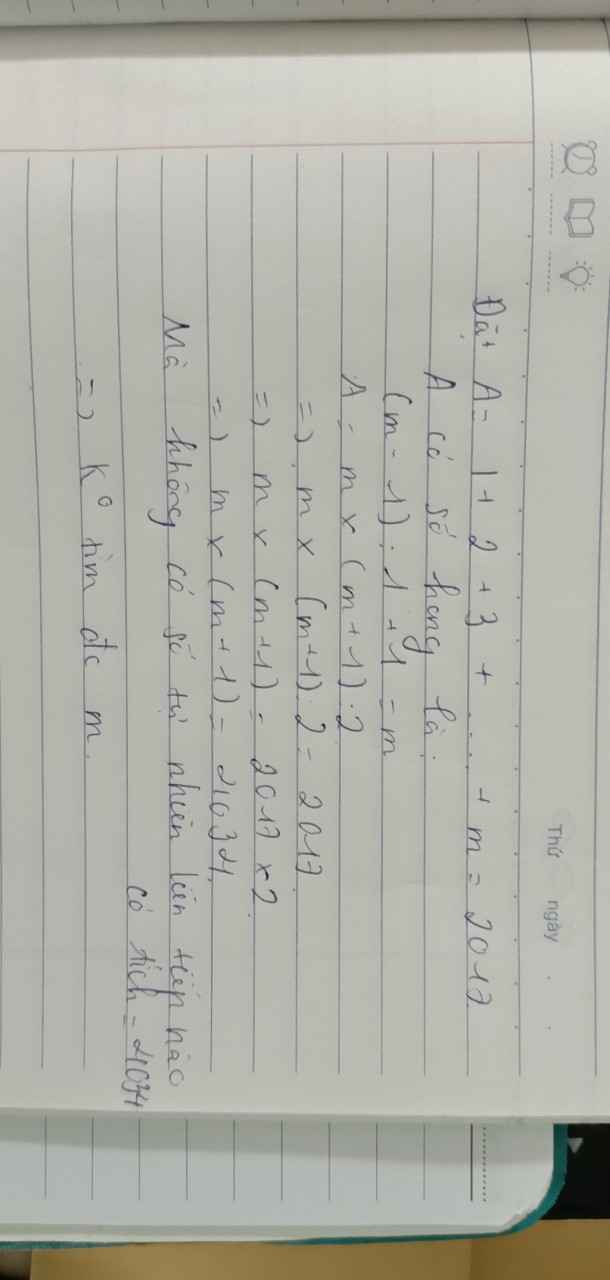Hãy nhập câu hỏi của bạn vào đây, nếu là tài khoản VIP, bạn sẽ được ưu tiên trả lời.

Xét khai triển:
\(\left(1+x\right)^{2017}=C_{2017}^0+xC_{2017}^1+x^2C_{2017}^2+...+x^{2017}C_{2017}^{2017}\)
Lấy tích phân 2 vế:
\(\int\limits^1_0\left(1+x\right)^{2017}=\int\limits^1_0\left(C_{2017}^0+xC_{2017}^1+...+x^{2017}C_{2017}^{2017}\right)\)
\(\Leftrightarrow\dfrac{2^{2018}-1}{2018}=C_{2017}^0+\dfrac{1}{2}C_{2017}^1+...+\dfrac{1}{2018}C_{2017}^{2017}\)
Vậy \(S=\dfrac{2^{2018}-1}{2018}\)

Xét khai triển:
\(\left(1+x\right)^n=C_n^0+C_n^1x+C_n^2x^2+C_n^3x^3+...+C_n^nx^n\)
Đạo hàm 2 vế:
\(n\left(1+x\right)^{n-1}=C_n^1+2C_n^2x+3C_n^3x^2+...+nC_n^nx^{n-1}\)
Thay \(x=1\) và \(n=2017\) vào ta được:
\(2017.2^{2016}=C_{2017^1}+2C_{2017}^2+3C_{2017}^3+...+2017.C_{2017}^{2017}\)

\(S=\dfrac{1}{2018!\left(2019-2018\right)!}+\dfrac{1}{2016!\left(2019-2016\right)!}+...+\dfrac{1}{2!\left(2019-2\right)!}+\dfrac{1}{0!\left(2019-0!\right)}\)
\(\Rightarrow2019!.S=\dfrac{2019!}{2018!\left(2019-2018\right)!}+\dfrac{2019!}{2016!\left(2019-2016\right)!}+...+\dfrac{2019!}{2!\left(2019-2\right)!}+\dfrac{2019!}{0!\left(2019-0\right)!}\)
\(=C_{2019}^{2018}+C_{2019}^{2016}+...+C_{2019}^2+C_{2019}^0\)
\(=\dfrac{1}{2}\left(C_{2019}^0+C_{2019}^1+...+C_{2019}^{2018}+C_{2019}^{2019}\right)\)
\(=\dfrac{1}{2}.2^{2019}=2^{2018}\)
\(\Rightarrow S=\dfrac{2^{2018}}{2019!}\)

\(A=\lim\limits_{x\rightarrow0}\dfrac{\left(x^2+2017\right)\left(\sqrt[5]{1-5x}-1\right)+x^2}{x}\)
\(=\lim\limits_{x\rightarrow0}\dfrac{-\dfrac{5x\left(x^2+2017\right)}{\sqrt[5]{\left(1-5x\right)^4}+\sqrt[5]{\left(1-5x\right)^3}+\sqrt[5]{\left(1-5x\right)^2}+\sqrt[5]{1-5x}+1}+x^2}{x}\)
\(=\lim\limits_{x\rightarrow0}\left(-\dfrac{5\left(x^2+2017\right)}{\sqrt[5]{\left(1-5x\right)^4}+\sqrt[5]{\left(1-5x\right)^3}+\sqrt[5]{\left(1-5x\right)^2}+\sqrt[5]{1-5x}+1}+x\right)\)
\(=-2017\)
dễ thấy hàm số trên có dạng 0/0
áp dụng quy tắc l'Hôpital
\(A=_{\lim\limits_{x\rightarrow0}\dfrac{\left(x^2+2017\right)\sqrt[5]{1-5x}-2017}{x}=\lim\limits_{x\rightarrow0}\dfrac{\left(\left(x^2+2017\right)\sqrt[5]{1-5x}-2017\right)'}{\left(x\right)'}}\)
\(A=\lim\limits_{x\rightarrow0}\dfrac{-x^2-2017}{\sqrt[5]{\left(1-5x\right)^4}}+2x\sqrt[5]{1-5x}=\dfrac{-2017}{1}=-2017\)

\(\Leftrightarrow\dfrac{2}{2}+\dfrac{2}{6}+\dfrac{2}{12}+\dfrac{2}{20}+...+\dfrac{2}{x\left(x+1\right)}=\dfrac{4032}{2017}\)
\(\Leftrightarrow2\left(\dfrac{1}{2}+\dfrac{1}{6}+\dfrac{1}{12}+...+\dfrac{1}{x\left(x+1\right)}\right)=\dfrac{4032}{2017}\)
\(\Leftrightarrow1-\dfrac{1}{2}+\dfrac{1}{2}-\dfrac{1}{3}+...+\dfrac{1}{x}-\dfrac{1}{x+1}=\dfrac{2016}{2017}\)
\(\Leftrightarrow1-\dfrac{1}{x+1}=\dfrac{2016}{2017}\)
\(\Leftrightarrow\dfrac{1}{x+1}=\dfrac{1}{2017}\)
=>x+1=2017
hay x=2016

Không tìm được vì phương trình m(m+1) = 2017 không có nghiệm tự nhiên

3.
Đặt \(f\left(x\right)=x^4-3x^3+x-\dfrac{1}{8}\)
Hàm \(f\left(x\right)\) liên tục trên R
Do \(f\left(x\right)\) là đa thức bậc 4 nên có tối đa 4 nghiệm
Ta có: \(f\left(-1\right)=\dfrac{23}{8}>0\)
\(f\left(0\right)=-\dfrac{1}{8}< 0\Rightarrow f\left(-1\right).f\left(0\right)< 0\)
\(\Rightarrow f\left(x\right)\) luôn có ít nhất 1 nghiệm thuộc \(\left(-1;0\right)\)
\(f\left(\dfrac{1}{2}\right)=\dfrac{1}{16}>0\Rightarrow f\left(0\right).f\left(\dfrac{1}{2}\right)< 0\)
\(\Rightarrow f\left(x\right)\) luôn có ít nhất 1 nghiệm thuộc \(\left(0;\dfrac{1}{2}\right)\)
\(f\left(1\right)=-\dfrac{9}{8}< 0\Rightarrow f\left(\dfrac{1}{2}\right).f\left(1\right)< 0\)
\(\Rightarrow f\left(x\right)\) luôn có ít nhất 1 nghiệm thuộc \(\left(\dfrac{1}{2};1\right)\)
\(f\left(3\right)=\dfrac{23}{8}>0\Rightarrow f\left(1\right).f\left(3\right)< 0\)
\(\Rightarrow f\left(x\right)\) luôn có ít nhất 1 nghiệm thuộc \(\left(1;3\right)\)
Vậy pt có 4 nghiệm thuộc các khoảng nói trên
4.
\(\lim\limits_{x\rightarrow-\infty}\left(\sqrt{x^2+ax+2017}+x\right)=\lim\limits_{x\rightarrow-\infty}\dfrac{ax+2017}{\sqrt{x^2+ax+2017}-x}\)
\(=\lim\limits_{x\rightarrow-\infty}\dfrac{a+\dfrac{2017}{x}}{-\sqrt{1+\dfrac{a}{x}+\dfrac{2017}{x^2}}-1}=-\dfrac{a}{2}\)
\(\Rightarrow-\dfrac{a}{2}=6\Rightarrow a=-12\)

\(A=x^2-x+1=\left(x-\frac{1}{2}\right)^2+\frac{3}{4}\ge\frac{3}{4}\)
\(\Rightarrow A_{min}=\frac{3}{4}\) khi \(x=\frac{1}{2}\), \(A_{max}\) ko tồn tại
\(B=x^2+2x+5=\left(x+1\right)^2+4\ge4\)
\(\Rightarrow B_{min}=4\) khi \(x=-1\) , \(B_{max}\) ko tồn tại
\(C=\left(5-x\right)^2+2017\ge2017\)
\(\Rightarrow C_{min}=2017\) khi \(x=5\) , \(C_{max}\) ko tồn tại
\(D=20-\left(2x+1\right)^2\le20\)
\(\Rightarrow D_{max}=20\) khi \(x=-\frac{1}{2}\), \(D_{min}\) ko tồn tại
\(E=x^2+2\left|y+1\right|+7\ge7\)
\(\Rightarrow E_{min}=7\) khi \(\left\{{}\begin{matrix}x=0\\y=-1\end{matrix}\right.\) , \(E_{max}\) ko tồn tại

Ta có 2 + 1 2017 = C 2017 0 .2 2017 + C 2017 1 .2 2016 + ... + C 2017 2017 .2 0
2 − 1 2017 = C 2017 0 .2 2017 + C 2017 1 .2 2016 . − 1 + ... + C 2017 2017 .2 0 . − 1 2017
Trừ từng vế hai đẳng thức trên ta được:
3 2017 − 1 = 2 C 2017 1 .2 2016 + C 2017 3 .2 2014 + ... + C 2017 2017 .2 0
Vậy M = 3 2017 − 1 2
Chọn đáp án D.